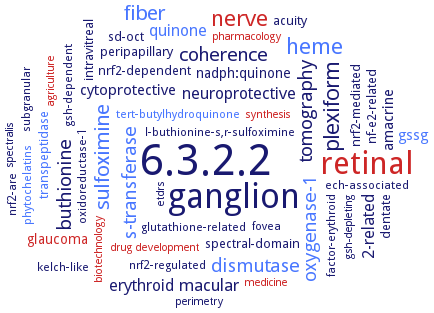6.3.2.2: glutamate-cysteine ligase
This is an abbreviated version!
For detailed information about glutamate-cysteine ligase, go to the full flat file.

Word Map on EC 6.3.2.2 
-
6.3.2.2
-
ganglion
-
retinal
-
nerve
-
heme
-
plexiform
-
fiber
-
sulfoximine
-
dismutase
-
coherence
-
tomography
-
buthionine
-
s-transferase
-
oxygenase-1
-
macular
-
erythroid
-
quinone
-
neuroprotective
-
2-related
-
amacrine
-
cytoprotective
-
gssg
-
nadph:quinone
-
glaucoma
-
nf-e2-related
-
acuity
-
transpeptidase
-
sd-oct
-
peripapillary
-
intravitreal
-
nrf2-mediated
-
nrf2-dependent
-
dentate
-
spectral-domain
-
nrf2-are
-
factor-erythroid
-
subgranular
-
glutathione-related
-
gsh-dependent
-
phytochelatins
-
l-buthionine-s,r-sulfoximine
-
tert-butylhydroquinone
-
oxidoreductase-1
-
ech-associated
-
kelch-like
-
nrf2-regulated
-
fovea
-
biotechnology
-
medicine
-
perimetry
-
synthesis
-
gsh-depleting
-
agriculture
-
drug development
-
etdrs
-
pharmacology
-
spectralis
- 6.3.2.2
-
ganglion
- retinal
- nerve
- heme
-
plexiform
- fiber
- sulfoximine
- dismutase
-
coherence
-
tomography
-
buthionine
- s-transferase
- oxygenase-1
-
macular
-
erythroid
- quinone
-
neuroprotective
-
2-related
-
amacrine
-
cytoprotective
- gssg
-
nadph:quinone
- glaucoma
-
nf-e2-related
-
acuity
- transpeptidase
-
sd-oct
-
peripapillary
-
intravitreal
-
nrf2-mediated
-
nrf2-dependent
-
dentate
-
spectral-domain
-
nrf2-are
-
factor-erythroid
-
subgranular
-
glutathione-related
-
gsh-dependent
- phytochelatins
-
l-buthionine-s,r-sulfoximine
- tert-butylhydroquinone
-
oxidoreductase-1
-
ech-associated
-
kelch-like
-
nrf2-regulated
-
fovea
- biotechnology
- medicine
-
perimetry
- synthesis
-
gsh-depleting
- agriculture
- drug development
-
etdrs
- pharmacology
-
spectralis
Reaction
Synonyms
Ace-GCL, Asuc_1947, AtGCL, bifunctional glutathione synthetase, bifunctional GSH synthetase, bifunctional L-glutathione synthetase, gamma -GCS, gamma-ECL, Gamma-ECS, gamma-GC, gamma-GCS, gamma-GCS-GS, gamma-glutamate-cysteine ligase-glutathione synthetase, gamma-glutamate-cysteine ligase/glutathione synthetase, gamma-glutaminylcysteine synthetase, gamma-glutamycysteine synthetase, gamma-glutamyl-cysteine ligase, gamma-Glutamyl-L-cysteine synthetase, gamma-glutamylcysteine ligase, gamma-glutamylcysteine synthase, gamma-Glutamylcysteine synthetase, gamma-glutamylcysteine synthetase-glutathione synthetase, gamma-Glutamylcysteinyl-synthetase, gammaGCS, GCL, GCLC, Gclc-X2, GCLM, GCS, GCSGS, ghF, GLCL, GLCLC, GLCLR, glutamate cysteine ligase, glutamate cysteine ligase gene, glutamate-cysteine ligase, glutamate-cysteine-ligase, glutamate�cysteine ligase, glutathione biosynthesis bifunctional protein GshAB, GSH1, GshA, gshAB, GshF, GshFAp, GshFAs, GSHI, I79_022778, L-glutamate L-cysteine ligase, More, PAD2, PhGshA II, PSHAa0937, StGCL-GS, Synthetase, gamma-glutamylcysteine


 results (
results ( results (
results ( top
top





